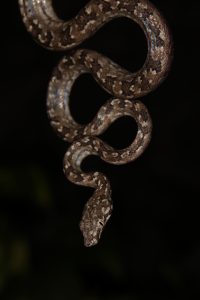Hispaniolan Vine Boa Is First New Boa Species In 133 Years From Island Of Hispanola
For the first time in over a century, a new boa species has been discovered in the Dominican Republic. University of North Carolina Asheville Associate Professor of Biology Graham Reynolds has collaborated with naturalist Miguel Landestoy and Milwaukee Public Museum Curator Emeritus of Herpetology Robert Henderson to proudly announce the discovery of the new species despite unimaginable odds.

Credit: © Miguel A. Landestoy T.
“It’s an incredible discovery,” says Reynolds, a National Geographic Explorer and a leading contributor to the study of the biology of boas worldwide. “The last boa discovered on this island was documented over 100 years ago. Yet even though this species was able to elude discovery until now, what might be considered even more remarkable is this boa’s efforts to persist despite the accelerated rate of habitat loss.”
The Hispaniolan Vine Boa (Chilabothrus ampelophis) was initially discovered by Landestoy in a remote southwest corner of the Dominican Republic near the Haitian border. A small snake in a tree appeared to be different from any other boa that he and his colleagues had encountered during their countless exhibitions and hours of research. Landestoy had a hunch this might be the first documented sighting of a new snake species.
“In the summer of 2020, two colleagues and I went on a nighttime excursion to escape the enclosure of the pandemic and to check on a recently discovered toad species,” recalls Landestoy. “My friend, Robert Ortíz, called me over to see a small, thin snake, and immediately I exclaimed ‘we just found a new species!’”
Landstoy enlisted the support of Reynolds and Henderson to analyze the DNA and records of boas from the region to confirm it had not been previously identified while he continued to uncover more specimens. With additional support from INTEC-Grupo Jaragua and the PEER/NAS/USAID Program, the collective analyses became unequivocal. The team had discovered a new species of boa that had effectively kept itself hidden from science in this remote region.

Landestoy, Reynolds, and Henderson have named this new boa species Chilabothrus ampelophis, the Hispaniolan Vine Boa. The name refers to the body shape of the animal, which is long and slender, as well as its habitat composed of tropical dry forest with plenty of vines. The species is entirely arboreal, living among the bushes, vines, and thin trees in a small patch of forest.
Each of the six snakes discovered by the researchers have been very small for a boa, all measuring less than a meter in length. A relative of the species found on the island of Hispaniola can reach lengths well over two meters and resemble the more universally familiar long and heavy-bodied boas from the Neotropics.
Sadly, the new species is experiencing rapid habitat loss due to documented agriculture incursion into its habitat and rapid tree cutting for charcoal production. “The Dominican Republic has become a restricted last resort for many species in this highly diverse southwestern portion of the island due to intensive land use on the Haitian side,” says Landestoy.
Upcoming planned research includes expeditions to document any other populations that might exist in the region and to better study the biology and conservation of the species.
“Habitats where previously hidden boa species are found, such as the Hispaniolan Vine Boa or the Conception Island Silver Boa (discovered in 2016), are dwindling,” says Reynolds. “We are lucky to have discovered these incredible creatures before they could be driven extinct. This discovery is further evidence that we still have much to learn about biodiversity in the region. Our task now is to use their discoveries to recognize the value of wild places in the Caribbean and generate action in preserving natural habitats.”
The paper, A Small New Arboreal Species of West Indian Boa (Boidae; Chilabothrus) From Southern Hispaniola describing these findings is currently in press at the journal Breviora, a Harvard University Museum of Comparative Zoology publication.
 A new species of small boa is discovered in a remote part of the Dominican Republic.
Credit: © Miguel A. Landestoy T.
A new species of small boa is discovered in a remote part of the Dominican Republic.
Credit: © Miguel A. Landestoy T.
Share
Permalink: